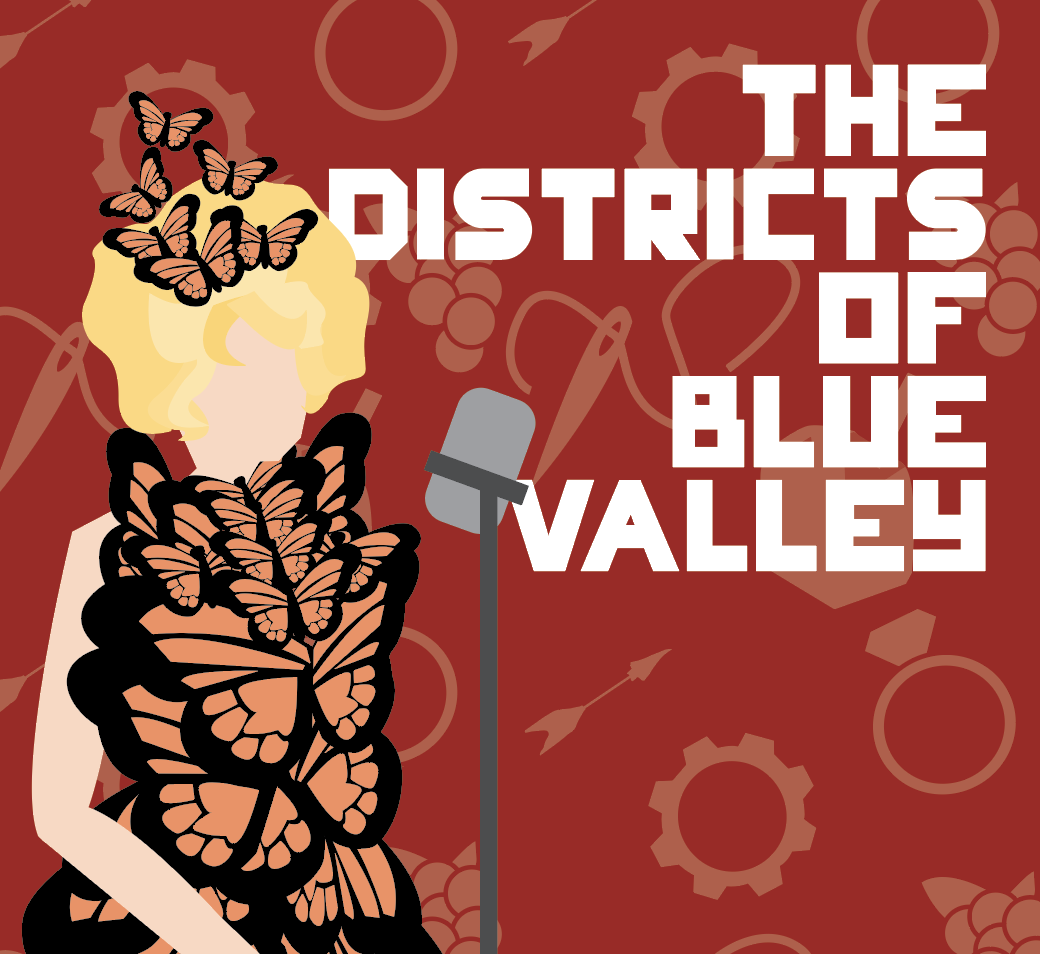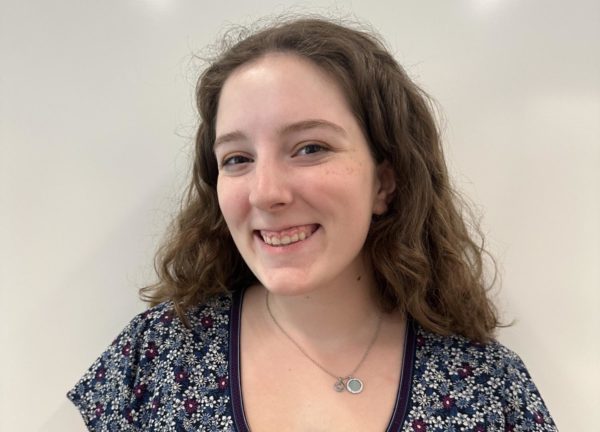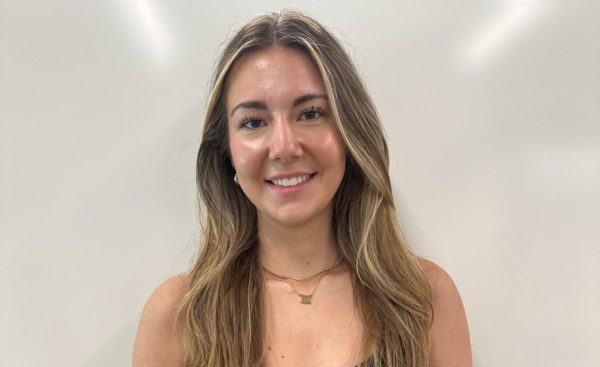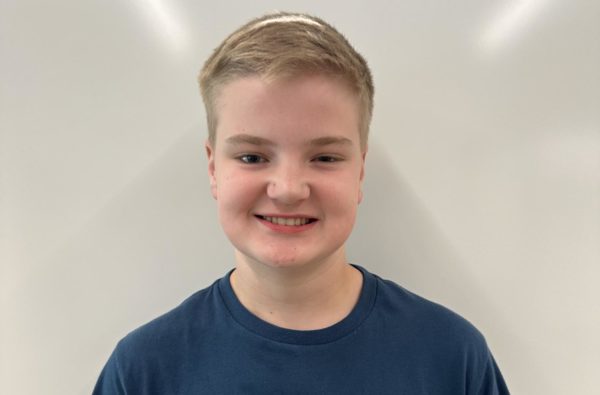In Suzanne Collins’ worldwide phenomenon “The Hunger Games,” the people of Panem are separated into districts based on their region’s most prolific export or industry. Similarly, the students of Blue Valley can be identified as belonging to many different groups, divided by interests, hobbies and jobs. Read on to learn more about a student who would fit into each of Panem’s 12 districts.
District 1: Luxury
In “The Hunger Games,” luxury goods such as fine jewelry and fur coats are highly sought after and are often hard to obtain without lots of money. Luckily, classes such as Jewelry and Metalsmithing are much more accessible and less high-stakes as the Hunger Games.
Junior Katie Mueller is one such student who has taken a particular interest in the craft of metalsmithing and fabricating pieces people can wear.
“I have been making jewelry since I started the class in freshman year,” Mueller said. “I decided to take the class because it sounded really cool — I mean, it’s called metalsmithing.”
The class allows her to have a degree of artistic license unique to art classes.
“You have a pretty high level of creative freedom, and there’s sort of an endless amount of techniques to explore,” she said. “You can come up with an idea and be able to make it.”
Although Mueller started out with the same project as every student who takes Jewelry and Metalsmithing I, a copper bookmark, now she is working on making different forms from metal.
“I have been trying to get out of making flat planes because a lot of jewelry making is cutting things out of sheets [of metal],” she said. “I’ve made a lot of things out of sheets that are just not flat or not cut out flat.”
One of Mueller’s favorite things about making jewelry is the longevity of the product itself.
“When I first started, it was about exploring new mediums of art and how you can uniquely express yourself in that medium,” she said. “A lot of jewelry is very durable and that makes it wearable, which is really cool.”
District 2: Archery
Unlike Katniss Everdeen, very few of us have a need to — or indeed, the means to — learn the art of archery.
However, junior Rylie Tschirhart regularly takes up the bow for sport, if not to fight for her life in an arena.
“My family’s really big on hunting,” she said. “My dad got into hunting and [while] he did use guns, he was more interested in the bow aspect — we all got really into compound bow hunting.”
According to Tschirhart, archery is much more complicated and difficult than people give it credit for.
“Most people, when they think of archery, just think of a simple bow — literally wood that’s curved [with] string,” she said. “But we use compound bows, which look really simple, but they’re more complicated because they have a peep and also these things called cams, which help you determine the weight you can pull back. There’s also crossbows, which is basically a gun mixed with a bow because there’s a scope on it, and you have to use all these devices to pull it back.”
Tschirhart said she and her family used to participate in competitive shooting but gave it up in favor of hunting.
“I prefer the thrill of [hunting],” she said. “Sometimes you just have to take a deep breath and make sure you’re not shaking even the tiniest bit because it’ll mess up your shot.”
Tschirhart wholeheartedly recommends archery to anyone who wants to try it.
“If you like being outdoors or want to try something new, it’s definitely something people should look into doing,” she said. “It’s really fun.”
District 3: Technology
During “The Hunger Games,” robotics are used for great effects. From advanced medicine to weapons of war, the Districts have it covered. During the Games, however, senior Liam Stewart thinks they might not be so helpful.
“If you’re in a situation where you have resources, I think it’d be pretty valuable for survival,” Stewart said. “But in general I don’t think it’d be super valuable.”
Robotics can be helpful, but without proper training and resources, they will have a negligible impact on a tribute’s chances of survival. Stewart also has some ideas on how robotics could be helpful to a survivor.
“You could have a robot that cooks food or heats you up,” he said.
A robot that can produce heat would help in many survival situations as it could keep you safe from cold arenas and reduce chances of consuming bad or raw foods.
Stewart is in robotics because he wants to be an engineer.
“It’s a cool way to tackle problems and solve them with innovative ideas,” Stewart said. “I get a chance to work a lot with my friends.”
In the real world, he thinks robots can be used to help people.
“Humans can do other jobs and have robots do those tasks for us and save us trouble,” Stewart said. “People can use robots to take over dangerous jobs and keep us safe.”
District 4: Fishing
For many people, fishing is something they only do on occasion, if ever, but for senior Luke Nolkemper, it is a beloved pastime.
“I’ve been fishing regularly for nine years,” Nolkemper said.
Nolkemper’s hobby came from a more general interest in the outdoors.
“I’ve always been drawn to water and love aquatic life,” he said. “I love being outside and exploring nature.”
However, fishing is not always fun and games. Though the actual act of fishing can be strenuous or time-consuming, Nolkemper’s struggle within it comes from something else.
“To me the most difficult part of fishing is avoiding purchasing new gear,” Nolkemper said.
Though fishing has its ups and downs, Nolkemper has always felt like the hard work he puts in has paid off.
“I’ve caught multiple blue catfish over 30 pounds at the Lake of the Ozarks,” he said.
Although the end goal of going fishing is obviously to catch fish, that is not what Nolkemper enjoys most about it.
“I love fishing because it takes me to different areas and locations,” he said. “Fishing is a great way to learn your nearby geography.”
District 5: Electricity
In the charged District of Electricity, PC building has grown to be a worldwide hobby for active gaming enthusiasts.
With the thousands of options of components, builders are given loads of customizations and combinations when constructing their own computers. The tech-heavy hobby has been predicted to only grow throughout the years.
Sophomore Brock Richardson has experience in building computers. Richardson first stepped into computer building with his friends.
“When I was introduced to PC building, I thought it would be very hard and intimidating,” he said.
For people looking to start the process of building a computer, Richardson advises builders to shop for all the computer parts separately and build it rather than buying the computer already assembled.
“Build it from scratch [so] when you’re upgrading it later it’s easier to take the [parts] out,” Richardson said.
Although hardware prices can be a shock to first-time buyers, it’s important to understand the reason behind the extreme costs.
“Don’t cheap out on the graphics card because that’s the component you want to be the best,” Richardson said.
He suggested investing in reliable, high quality parts rather than cheaper ones to make your computer last a lifetime.
“Go to Micro Center for in-person [and] Amazon for online [shopping],” Richardson said.
He utilized both marketplaces when building his own computer, and he encourages builders to do the same as he found them to be great resources.
Richardson said being careful to not break any parts is the most important thing when building a computer.
The installation of the Central Processing Unit is typically known to be nerve-racking since it contains from 1,200 to 1,500 tiny pins that must be aligned to the motherboard.
“Putting the CPU in [is scary] because you have to be careful [aligning] the pins — it’s very fragile,” Richardson said.
Although computer building consists of many anxiety-inducing steps, other parts encompass a more gratifying task, making the build feel rewarding and complete.
“My favorite component to put together was the RAM,” Richardson said. “It’s satisfying to put everything together, and when you’re finished it’s a cool thing to see what you built. It’s an accomplishment.”
District 6: Transport
With Panem being covered in its distinct districts, traveling by train is how citizens and district competitors move. But, for sophomore Emma Crosier, she has traveled much more than others might have.
“I went skiing last year for my first time in Arizona,” Crosier said.
Despite Arizona being known for its extreme heat, Crosier enjoys the opportunity to see new and unique places.
“I like trying all the new food in all the different states,” Crosier said. “It’s always a new experience at each place.”
While many only travel within the United States, Crosier has gone elsewhere also. Ideally though, she’d like to go to Bora Bora.
“I like the little tiki huts that float on the water there, and they are so cute,” Crosier said. “It’d be a great place for photos.”
But, there are still downsides to being able to see such beautiful places.
“I hate airports,” she said. “It’s just so gross and disgusting.”
Despite that though, Crosier still continues to travel and loves the places she goes, especially one particular experience.
“I went on a Norwegian Cruise — we got to see a lot of glaciers and see the huskies race,” Crosier said. “It was really beautiful and scenic.”
Ideally, Crosier said traveling is meant to give people “experiences in scenery that you don’t see every day.”
District 7: Lumber
rovides lumber and wood for the entire city of Panem as they construct new projects and buildings.
In a similar manner, senior Preston Baker is someone who wants not only to get a degree in architecture, but one of the few wanting to double major in architecture and architectural engineering, setting himself up for success for life after college.
Originally though, his interest in wanting to become an architect started at a young age.
“At first it was just me and my dad running around neighborhoods looking at houses and seeing stuff — but more recently, it’s actually been the math and actual sciences behind it,” Baker said. “It’s become so interesting to me that I don’t think there’s anything else or any major that really interests me at all.”
Of course, being successful in both majors is something that requires a lot of hard work and patience.
“The hardest thing about becoming an architect is the labs,” Baker said. “It’s like three days a week, and you’re stuck in a room for three hours working on whatever project you’re handed.”
On top of that, Baker has to learn how architects write on blueprints for projects and their designed plans.
“You have to learn the calligraphy of architecture,” Baker said. “It’s so different from my handwriting — it’s going to be a major learning curve.”
Despite the challenges he might face in college, becoming an architect is something he looks forward to.
“I’m excited for it,” Baker said. “It’s something I want to do for the rest of my life.”
District 8: Textiles
When one thinks of forms of art, they might imagine drawing, painting or sculpting, but often overlooked is the art of sewing. And although the people of District 8 likely don’t specialize in creating costumes, senior Evelyn Burgess does.
“I picked up sewing when I was in sixth grade because I had an interest in cosplay and making costumes,” Burgess said.
Since her passion for sewing is so strong, Burgess is almost entirely self-taught.
“I ended up teaching myself with my mom’s old machine she got as a gift from her grandmother in 1990-something,” Burgess said. “I was able to teach myself a lot of very basic skills for a long time.”
Though she could spend her time making regular shirts or pants, Burgess harnesses her skills for a more creative output: costumes.
“I’m a competitive cosplayer,” Burgess said, “What I do is I enter costumes I make in competitions. I really like putting together a lot of detailed and ornate work on my costumes and making it very clean.”
Spening time stitching, heming and creating costumes, Burgess has gained views toward sewing that most people don’t typically consider.
“The coolest thing is how deeply connected [sewing] is to math,” Burgess said, “I really want to study how things like math have to do with garment construction, drafting and patterning. There’s many times where I’ve gotten myself confused about attaching a lining to the garment. There’s holes in the garment, and you have to attach the lining with the holes, but you also can’t accidentally make a bag, which happens really often. I like to observe why that happens.”
Whether others want to be a competitive costume creator or not, sewing is still a useful skill to have in the eyes of Burgess.
“I definitely recommend the hobby,” she said. “It doesn’t even need to be anything serious like getting into competition. It’s a skill that’s very useful and can save you a lot of money if you can understand how to use a sewing machine, how to hand stitch things, how to fix buttons, how to darn, how to tailor or even maybe change the length of a hem.”
District 9: Bakery
Though it’s doubtful that anyone in the capital would declare, “let the tributes eat cake!,” senior Ava Nguyen has different ideas.
“I do most of my work on commission — I’ll bake upward of 300 to 600 things at a time; sometimes I do cupcakes but I prefer cookies,” she said. “I usually volunteer to do it, but I’ve had several customers pay me for my work — though, I usually charge very, very cheap because I like to bake.”
Nguyen claims that while she enjoys baking, she would never consider it as a occupation.
“I like baking as a hobby,” she said. “Turning it into a career would take all of the joy out of it.”
While she certainly enjoys baking, Nguyen does not feel her hobby holds an integral role in society.
“I think family-owned bakeries are good, but at the same time, you can get a loaf of sourdough at Walmart for like $7,” she said. “I’d say [corporations] are really dominating the bread market, and I think that’s what [the problem] is. Anybody could bake or do their own baking. If you don’t have time for that, [bakeries] could be useful.”
When she’s not working on commission or volunteer projects, Nguyen enjoys baking a variety of treats, both sweet and otherwise.
“I make bread a lot,” Nguyen said. “My favorite to make is probably pita bread — it’s very versatile. You can use it in so many different ways. I love having it alongside hummus. My mom makes her own hummus, and I’ll make pita bread and then gobble it.”
District 10: Animals
Kansas is stereotyped as a rural environment with farms and stables. Although Overland Park breaks this stereotype with an urban area, many people still enjoy simple activities such as horseback riding.
Junior Anna Kate Schweers has participated in English horseback riding since she was 5 years old. The love of horses grew from her mother who built a stables eight years ago.
“The land has been my mom’s since she moved here, and I remember it being a blank field originally,” Schweers said. “I remember a bunch of tall grass and now there’s a barn, it’s hard to imagine the grass being there now.”
Like many families in the rural part of Stilwell, Schweers had land. Instead of keeping the property undeveloped, they decided to build a stable for English riding. Many stalls were added in addition to tracks, inside and out.
“Right now we have 24 stalls and two horses in the pasture,” she said.
Although Schweers said horses are pretty and fun to ride, extra work plays into owning this animal. It not only takes acres of land and supplies, it takes time.
Schweers spends a lot of time at the stables riding or helping out. Due to her work, she has an early release. Her family spends their time and money keeping these animals and helping their owners.
“If someone was looking to keep a horse at the stables, it is $750 a month,” she said. ”That covers hay, shavings, riding, and cleaning. We have someone that [cleans] stalls for us.”
District 11: Winery
To a lot of people in Overland Park, agriculture may seem like an abstract idea, but that’s not always the case. Senior Audrey Vore’s family has owned a winery for seven years.
She works at Isinglass Estate Winery and knows the process it takes to make wine. Not only does wine making take a long time, it takes a lot of land.
“We have 40 acres of grapes and grow blackberries to put into our blackberry wine,” Vore said.
There are also different types of wine, and depending on how they are created, it will play into what type of drink is made.
“If you’re making a white wine, it takes three to six months,” she said. “If you’re making a red wine, it can vary between a year or two, depending on how [long] you want it to be in the tank.”
Not only does the type of wine depend on the processing time, it has a multitude of factors.
“How long you ferment them, how sweet you make them — the longer you ferment a wine the dryer it gets,” she said. “Dry wines have more alcohol, and then you can sweeten it back up.”
Although Vore is knowledgable about wine, she does not personally make it — she has a different task at the winery: helping customers when they visit the property. Vore has many other duties, but mainly she is on the front line working with people.
“I help bottle the wines whenever we’re done making them, and then I serve them to people,” she said.
District 12: Fuel
Although District Twelve’s residents were only allowed to do laborious work in mines at 18, this group of boys think otherwise, working on vehicles to ensure they can solve problems independently.
Juniors Ben Soykan, Alex Whitehair, Owen Young and Liam Gaddie had their interests sparked to work on their trucks as a means to be more capable than the ordinary.
For Soykan, this inspiration was sparked by his older brother.
“Changing my starter and alternator was the first somewhat large project I did with zero knowledge, and I had to just figure it out the hard way [as I lit my truck on fire],” he said. “Working on cars has completely changed my career aspirations and opened up my opportunities a lot because I can apply my skills to other places in life.”
When it comes to specific challenges, Gaddie said “getting deep” into a car or truck gives him something to do and also helps him learn new skills.
“I like to work on the suspension parts of cars and trucks,” Gaddie said. “It’s what I started out with and have a lot of knowledge in.”
Researching the latest developments in automotive technology helps Young come up with new ideas.
“Modifications [are] more fulfilling because you can make your vehicle however you want, and being different stands out more than a normal vehicle,” he said. “I like knowing I’m doing [what] not everyone is able to do and have knowledge of.”
In addition to working on vehicles, Whitehair also runs his own gig mowing lawns, raking leaves and shoveling snow. One of his specialties and favorite aspects of vehicle repair is repairing mowers.
“I find doing normal maintenance fulfilling because it keeps it running great and is very easy,” Whitehair said. “I was inspired from my friends and family. It’s a fun hobby, and you can save a little money as well.”
For these juniors, working on vehicles isn’t just trivial — it is a skill they will use for the rest of their lives.
“My dad showed me how to do my first oil change and since then it grew into bigger projects,” Gaddie said. “Working on vehicles has influenced me to start a job that I professionally work on vehicles and also attend classes for certifications.”
Where does BV think they belong?
District 1: Luxury – 17%
District 2: Weaponry – 2%
District 3: Technology – 23%
District 4: Fishing – 5%
District 5: Electricity – 4%
District 6: Transport – 7%
District 7: Lumber – 5%
District 8: Textiles – 12%
District 9: Grain – 3%
District 10: Animals – 9%
District 11: Agriculture – 9%
District 12: Fuel – 4%
117 students surveyed











